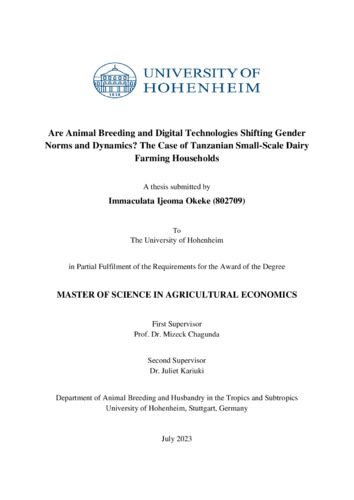Are animal breeding and digital technologies shifting gender norms and dynamics? The case of Tanzanian small-scale dairy farming households
Abstract
Gender dynamics and norms are crucial for rural livelihoods and achieving food security. While norms related to ownership, management, product distribution, and sales methods are prevalent in dairy production, more research needs to be conducted in this area. This study hypothesized that innovative technologies introduced without considering gender dynamics and norms may limit the extent of transformative change. Using gender-sensitive mixed methods, this study investigated the potential implications of introducing technologies for intra-household dynamics and gender norms in dairyproducing communities. The African Asian Dairy Genetic Gains Programme (AADGG) has been introducing improved genetics, precise breeding techniques, and telemetric data recording technologies in smallholder dairy farms in Tanzania, and this served as the study case. Intra-household data were collected from 180 smallholder farmers surveys, gender-aggregated focus group discussions involving 80 farmers, and six expert interviews. Data were analyzed using content analysis, descriptive statistics, the percentage rate of change, and the coefficient of variation. Age, education, gender, household size, household role, and farming system practiced were found to be significant determinants of the adoption of digital dairy applications (DDAs). Introducing dairy breeding technologies reduced women’s control over milk incomes in two ways. First, improved breeds led to women and men participating in milking, previously carried out solely by women. The increased profitability of the dairy enterprise raised the outlook and status of some chores related to dairy farming. The shift, although linked with women’s economic empowerment and gender-equal distribution of household responsibility, resulted in the transfer of milk income from women to men in most cases. The transfer of milk income from women to men demonstrates a marked shift in women’s traditional roles, from exclusive homemakers in charge of the overall well-being of the household to dependents on their husbands for money to meet household nutritional and welfare needs. The study revealed that both male and female male and female dairy farmers are now venturing into and taking control of dairy breeding activities by the opposite gender. The situation shows that tasks and responsibilities in dairy breeding, traditionally assigned to either men or women, are now actively pursued and led by both genders. In the majority of survey responses (99.9%), the study showed that technological improvement led to milk increase. The milk increase did not, however, necessarily correspond to higher income for farmers during the wet seasons, as the milk market would easily oversaturate due to excessive supply, culminating in low prices. The study views this situation as perception-based low milk pricing because the majority of respondents interviewed for this study were “borderline educated farmers” (farmers with primary education) who might not be able to understand the economics of production (input and output). These farmers might be unable to calculate the labour input, time, and opportunity cost of producing milk in the wet season against the milk price. The shifting dynamics in gender norms may have positive and negative consequences on household food security, nutritional status, and general livelihoods. However, the severity within households depends on the dairy farmer’s household type and marital status. These findings suggest innovative technologies are more likely to have transformative outcomes if tailored to suit the needs of different gender groups, consider prevailing societal and gender norms, and be accompanied by requisite training on further innovations that would mitigate the consequences of the current innovations. Also, introducers of dairy breeding technologies should consider training farmers on dairy farming input, output recording, and basic profit and loss calculation to better understand milk prices in different production seasons.

